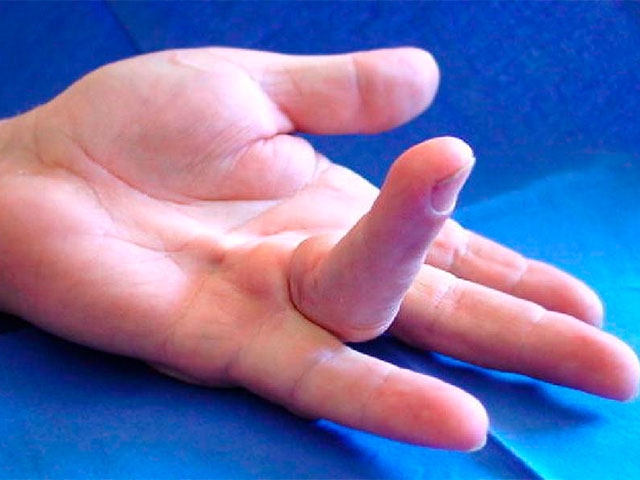The Dupuytren disease is a disease of the palm of the hand and was first described by Mr. Baron Dupuytren in 1831. It is a very frequent hand problem, but even now it is still not known what is the cause of Dupuytren’s disease.
Symptoms
The Dupuytren’s disease affects only the palm of the hand. It is one of the genetically manifested diseases and therefore cannot be cured. Compared with other hereditary diseases, such as rheumatoid arthritis or gout, it is not as disabling nor as painful and it does not spread around in the body. But a correlation has been found between Dupuytren’s disease and other diseases including diabetes, rheumatoid arthritis, alcoholism, phimosis (tight foreskin of the penis) and the same appearance of the disease affecting the sole of the feet (called Ledderhosen’s disease).
Although the disease is well described in the literature, orthopaedic surgeon Dr. Alf Neuhaus points out that it is often treated inadequately. The first symptoms are often not even recognized. The Dupuytren’s disease most frequently effects the fourth and fifth fingers. The disease forms fibrous bands and nodules which grow in the palm of the hand, normally starting at the level of the skin crease going across the hand close to the knuckle joint of the fingers, at the beginning often mistaken for callus formation. Years or even decades later these nodules slowly grow to become bands and strings of strong scar-like tissue. These nodules and bands won’t cause any pain at all, but by growing further they start to wind around the tendons in the palm of the hand that bend the fingers. The fingers starts to get pulled towards the palm of the hand, making it unable to straighten the finger(s) out.
This permanently bent finger or fingers can handicap the person dramatically making simple daily activities such as holding a glass, cooking, ironing, writing or driving a car very difficult. Most people don´t seek advice or help until the deformity starts to get in the way because there is usually no pain associated with this. Occasionally, it can cause pins and needles in the affected fingers.
Treatment and Care
The only proper treatment option is surgery. Orthopaedic surgeon Dr. Alf Neuhaus, trained in hand surgery, would remove those nodules and fibrous bands during surgery, to allow the affected tendons to move freely again. The time to operate is determined by the amount of extension deficit of the finger (how far the finger is pulled into the palm). If only a minor degree of extension deficit is present surgery can wait for a while. But if a finger is already bent almost completely into the palm of the hand it may be too late for the removal of the fibers due to technical difficulties of actually getting to the palm and the only option would be amputation.
The post operative care is not easy, involving splinting of the hand for several weeks and hand therapy, done in the fully equipped physiotherapy room of Clinica SANDALF. But the result is usually very satisfying, allowing the patient to return to normal daily activities including sports within 8 to 12 weeks. The patient should always be informed that surgery only removes the obvious bands and that the disease may grow again in other parts of the hand. But that might take many years before any effect is noted. If you would like more information about Dupuytren’s disease or any other hand problem please click here.

